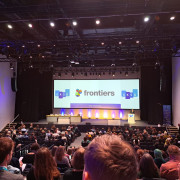- Science News
- Frontiers news
- Elodie Genevieve Germaine Vandelle – Follow your passion
Elodie Genevieve Germaine Vandelle – Follow your passion
Author: Alessandra Scala
Today, we speak to Elodie Vandelle, Associate Professor in Plant Pathology at the Department of Biotechnology at the University of Verona, who is involved in studying the interaction between plants and pathogenic microorganisms. Her recent line of research studies the bacterial virulence of phytopathogenic bacteria using kiwifruit plant models. We talk about being a ‘plant doctor’, touch upon the challenges of motherhood and opportunities for female researchers.

Elodie Vandelle (photo credit: Massimiliano Spiazzi)
Why the kiwifruit?
Kiwi is a very important culture for Italy which is the world’s second producer, and especially for the Veneto Region. Ten years ago, the entire kiwi cultivation was destroyed by an attack of this bacterium causing devastating economic repercussions. Therefore, the Veneto region has dedicated funds to study this pathogen and in particular to find solutions to treat kiwi plants. It all started with this regional project and subsequently became my research focus.
Did you think of becoming a phytopathologist as a kid?
Absolutely not! When I was in high school, I remember promising myself not to ever work with plants because the lesson on chlorophyll photosynthesis was not enjoyable. At some point I wanted to be a scientific journalist as I quite liked writing and applying scientific approach to understand things around us. I knew it would be science related. Eventually, I enrolled in the Faculty of Medicine in France, but I failed to pass the entrance test. The following year I tried again, and I managed to enter the class and to attend the second year of Biology where I discovered biochemistry and I immediately fell in love with it. I did the master's thesis with my professor of Biochemistry on plant defense mechanisms, and then the doctorate in the same field followed by the postdoc. One could say I became a plant pathologist almost by chance. But now I am a plant doctor.
If you could meet yourself at the beginning of your university journey, what advice would you give?
The message is to hold on, you'll make it! Whenever you find yourself in difficulties, do not despair, there is always be a way out. I did not have a steady job position for fifteen years but nevertheless I managed to keep my motivation. So, this is the overarching message: don't lose the will to achieve your goals. I don't think the difficulty of doing research is a question of differences between men and women because precariousness is unnerving and challenging for everyone. The only difference in career pathways is that we have motherhood (when we are lucky and if we want it) which makes us slow down our race for a steady position, because motherhood forces you to put many things on stand-by.
Speaking of motherhood, how do you keep the balance between work and family?
This is called developing the art of the tightrope walker. How do you do it? You lean here and there; you stay on the wire without falling. This goes for both children and work. My kids always ask about my work, and before COVID-19 pandemic I often used to take them to the laboratory. Probably, without them my whole life would have revolved around research, but having children certainly has put my feet on the ground.
They remind me that the hours of research are limited and that's fine. My passion for research in unquestionable and I have always lived in rhythm with experiments. I await the experiment results with trepidation: if they match my hypothesis, I return home very happy; if they don’t, I can come home sad and even frustrated, but my children simply do not allow me to remain so. You really must change the mood for them. The most difficult period for me was when they were very young because I had the sense of guilt leaving them at home while going to work which I enjoyed. Now, my children are 4 and 9 years old and I see that they understand how important it is for their mum to be happy. For me, the family is a source of energy to be able to work with motivation and, on the other hand, work is a source of change of the perspective. They balance and support each other. They are the weights I use to be a good tightrope walker.
Do you tell science-based stories to your children?
Definitely! Once, while working on the kiwi project, I had to prepare a lay scientific presentation without too much technical detail which I accompanied it with drawings of the bacterium when it was nasty, when it became gentler and when the plant defended itself. This presentation was tested on my curious son and actually turned into a little story. Often, he shows me a plant or a leaf asking about the spots and whether the plant is sick and what disease it might be.
It is great to see him taking a keen interest in the lab work too. Last Saturday, for instance, he came with me to the laboratory and checked the fume hood, then he played with the Eppendorf tube (with just water and no bacteria) imitating me at work. He was very proud and happy. A little researcher in the making!
What excited you the most about being a plant doctor? What does the future hold for your research field?
I am super passionate about the communication aspect in relationship between plants and microorganisms, especially bacteria. Communication with the host is also true for all plant pathogenic microorganisms. There is the plant that speaks with the plant, the plant that communicates with the bacterium and the bacterium that communicates with the plant. The signals are exchanged, there is a dialogue, the famous molecular dialogue that we explain to students in classrooms really exists and I find this incredible. I hope that one day we will be able to completely understand this language so that we could control and decode the messages that plants and pathogens exchange. Decoding communication is the key to everything and it fascinates me the most.
I believe plant pathology as a field was born to find solutions to heal and protect plants from diseases. I hope that in this field we, as the research community, can find real alternative and sustainable strategies. Using natural molecules or natural extracts are ideas that have been discussed for many years, but their application is quite recent and, obviously, the effects of these molecules have not yet been studied in depth. I truly hope that we will be able to find some long-term sustainable solutions to protect plants from major diseases.
Furthermore, I wish that in the near future we could reconsider transgenic or cis-genic plants. Perhaps it is easier for public acceptances to allow gene-edited plants for their useful applications. Here at the Biotechnology Department many of my colleagues work on the technologies to improve or solve many agricultural-related issues and to understand the biological processes behind the mechanisms that control the pathogenic plant interaction.
Do you feel the need for more scientific disclosure for science to be understood and accepted by the public?
Totally. Just to give an example, I remember hearing on the radio many years ago that most people rejected GMOs but only 47% of the same interviewed pool knew that there were DNA and genes in plants. If this was a well-known notion, public opinion on this technology would not be so much against.
When we do not know and we do not have the means to understand, fear is legitimate. With better communication and disclosure, we would probably be able to pass scientific concepts and make them accepted faster. For scientists like me it is difficult to explain in simple words our knowledge because we are afraid of leaving out details that seem absolutely fundamental to grasp the meaning without making it too complex. We can hardly expect someone to understand a complicated matter in an hour given it had taken us ten years to understand the same notion.
In my opinion, as scientists, we must make more and more effort to carry out scientific dissemination projects outside the scientific community as opposed to just publishing articles. Both scientific and journalistic competence is required to explain complex notions and concepts in a complete and comprehensible way. Starting to spread science in schools is the first fundamental step. If we can explain something to 10-year-olds at school, we can do it for the older ones.
Touching upon other challenges in the current research environment, what do you think about the “pink quotas”?
For the moment, they are necessary to avoid situations of female exclusion, but their implementation and use should not override the merit. These quotas have the medium- and short-term objective of focusing attention on the issue of disparities but in the long term I hope that there is no longer need to use them and that it is finally recognized that the skills for men and women are equal, or different but of equal value. I don't really like Women's Day as the day to recognize that women are important because women must be acknowledged 365 days a year. In my personal journey, I don't think I have suffered as a woman from prejudices, at least in my path, or from discrimination. We really have put discrimination in the spotlight: we talk about it and try to get women to talk about their experiences like in this blog. Hopefully, it will soon be a matter of the past.
What is the message you would like to pass on to girls who are approaching the world of research?
To not give up due to the difficulties encountered in the world of research and academia. Things are slowly going to change thanks to the attention paid to certain inequalities. The world is the same for everyone and female researchers must have their own place. Not becoming “as men” but being themselves, with their differences, strengths, and weaknesses. If we look at the numbers of associate and full professors, this gap between male and female tends to be reduced and female researchers are getting more and more into leading positions. I am confident that the gap will narrow even further and subsequently disappear completely. We should all have the same possibilities. If we do not, we must make ourselves heard.
* quotas for women in science

Frontiers is a signatory of the United Nations Publishers COMPACT. This interview has been published in support of United Nations Sustainable Goal 5: Achieve gender equality and empower all women and girls.







